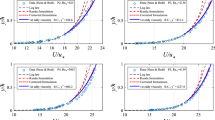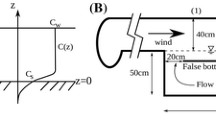Abstract
In a recent paper published in Environmental Earth Sciences, Jain et al. (Environ Earth Sci 77:253, 2018) proposed an interesting study about the \(\beta\)-factor (the inverse of the turbulent Schmidt number, i.e. the ratio of momentum diffusivity to mass diffusivity in a turbulent flow). They proposed an equation for the depth-averaged \(\beta\)-factor which was used in the Rouse equation to calculate concentration profiles of suspended sediments in open-channel turbulent flows. Despite the interest, the study shows a weakness related to some inconsistencies and contradictions in the method. The main result should be improved. In this note, the weakness in this study will be pointed out. Some used equations are in contradiction with the initial assumptions. The Rouse equation is a solution of the steady-state one-dimensional convection–diffusion equation with a parabolic eddy viscosity which is based on a logarithmic velocity profile. In the same study, Jain et al. (2018) used two different mixing length equations, parabolic and linear relations. The parabolic mixing length and a constant mixing velocity are in contradiction with the used exponential-type eddy viscosity profile. The used equation for coefficient \(\gamma\) is based on the finite mixing length model and the related assumptions of a linear eddy viscosity and a logarithmic velocity distribution (Nielsen and Teakle in Phys Fluids 16(7):2342–2348, 2004) which are in contradiction with the used exponential-type eddy viscosity profile and velocity distribution. An improved approach and new equations for the depth-averaged \(\beta\)-factor are proposed. The first is based on the equation for the coefficient \(A\) proposed by Jain et al. (2018) and a second based on a linear function for \(A\) which gives an equation for \(\beta\) similar to that of van Rijn (J Hydraul Eng ASCE 1104(11):1613–1641, 1984).
Similar content being viewed by others
References
Absi R (2000) Time-dependent eddy viscosity models for wave boundary layers. In: Edge BL (ed) Coastal engineering 2000, Proc. 27th international conference on coastal engineering, ASCE Press, vol 2, pp 1268–1281
Absi R (2005) Comment on turbulent diffusion of momentum and suspended particles: a finite-mixing-length theory. Phys Fluids 17(7):079101
Absi R (2010) Concentration profiles for fine and coarse sediments suspended by waves over ripples: an analytical study with the 1-DV gradient diffusion model. Adv Water Resour 33(4):411–418
Absi R (2011a) Discussion of vertical mixing in the fully developed turbulent layer of sediment-laden open-channel flow. J Hydraul Eng ASCE 137(9):1094–1095
Absi R (2011b) An ordinary differential equation for velocity distribution and dip-phenomenon in open channel flows. J Hydraul Res 49(1):82–89
Absi R (2019) Eddy viscosity and velocity profiles in fully-developed turbulent channel flows. Fluid Dyn 54(1):137–147
Absi R, Marchandon S, Lavarde M (2011) Turbulent diffusion of suspended particles: analysis of the turbulent Schmidt number. Defect and diffusion forum. Trans Tech Publ 312–315:794–799
El Gharbi N, Absi R, Benzaoui A (2012) Effect of different near-wall treatments on indoor airflow simulations. J Appl Fluid Mech 5(4):63–70
Fu X, Wang G, Shao X (2005) Vertical dispersion of fine and coarse sediments in turbulent open-channel flows. J Hydraul Eng ASCE 131:877–888
Gualtieri C, Angeloudis A, Bombardelli F, Jha S, Stoesser T (2017) On the values for the turbulent schmidt number in environmental flows. Fluids 2(2):17
Jain P, Kumbhakar M, Ghoshal K (2018) A mathematical model on depth-averaged β-factor in open-channel turbulent flow. Environ Earth Sci 77:253
Knight DW, Wright NG, Morvan HP (2005) Guidelines for applying commercial CFD software to open channel flow. Report Based on research work conducted under EPSRC Grants GR/R43716/01 and GR/R43723/01. p. 31. Available online: http://www.nottingham.ac.uk/cfd/ocf/Methodology.pdf. Accessed 06 Feb 2020
Montes V (1973) Interaction of two dimensional turbulent flow with suspended particles. Ph.D. thesis, Massachusetts Institute of Technology, Cambridge
Nielsen P, Teakle IA (2004) Turbulent diffusion of momentum and suspended particles: a finite-mixing-length theory. Phys Fluids 16(7):2342–2348
Rossi R, Iaccarino G (2009) Numerical simulation of scalar dispersion downstream of a square obstacle using gradient-transport type models. Atmos Environ 43:2518–2531
Toorman EA (2008) Vertical mixing in the fully developed turbulent layer of sediment-laden open-channel flow. J Hydraul Eng ASCE 134(9):1225–1235
Van Rijn L (1984) Sediment transport, part II: suspend load transport. J Hydraul Eng ASCE 1104(11):1613–1641
Welderufael M, Absi R, Mélinge Y (2019) Assessment of velocity profile models for turbulent smooth wall open channel flows. ISH J Hydraul Eng. https://doi.org/10.1080/09715010.2019.1677180
Author information
Authors and Affiliations
Corresponding author
Additional information
Publisher's Note
Springer Nature remains neutral with regard to jurisdictional claims in published maps and institutional affiliations.
Rights and permissions
About this article
Cite this article
Absi, R. Rebuttal on “A mathematical model on depth-averaged β-factor in open-channel turbulent flow” Environmental Earth Sciences 77:253 (2018). Environ Earth Sci 79, 113 (2020). https://doi.org/10.1007/s12665-020-8849-0
Received:
Accepted:
Published:
DOI: https://doi.org/10.1007/s12665-020-8849-0




